Water and Wastewater Engineering
Подождите немного. Документ загружается.


HEADWORKS AND PRELIMINARY TREATMENT 20-21
2. Sensors for headloss should have nothing in the channel that may be fouled by debris, rags,
and other flotsam. Differential bubbler, radar, and ultrasonic devices to measure the depth
of the wastewater are acceptable alternatives.
3. The stop log grooves or channels may become a serious corrosion proble
m. A chain fall to
raise and lower each stop log plate is recommended. Operators prefer slide gates rather than
stop logs.
Fine Screen Options
There are a number of options in the selection of fine screens and very fine screens. The screen
size (opening) is often based on the downstream processes to be employed. There is no definitive
classification scheme, but several broad categories may be defined. These include the following:
• Band screens. Perforated panels attac
hed to a drive chain act as the screening mechanism.
The flow pattern may be through the front and back side of the panel. In this configuration
a brush and spray bar clean the back side of the screen.
In an alternate configuration, the center-feed band, wastewater enters through the cen-
ter of the screen and exits out the sides.
•
Bar screens. These are sim ilar to bar racks but with finer openings. They are front clean/
back return.
• Drum screens. The screening medium is mounted on a cylinder that rotates in a flow chan-
nel. The flow may be from inside the drum to the outside with screenings captured on the
interior surface, or the flow may be from the out
side in.
• Step Screens
®
. This design consists of two step-shaped sets of thin vertical plates. One is
fixed and one is movable. They alternate across the screen face. The movable plates rotate
in a vertical motion to carry the solids up to the next step and ultimately to the top where
they are discharged.
The advantages
and disadvantages of thes e screens are summarized in Table 20-6 . In general,
fine screens can be rotated out of the screening channel for service.
TABLE 20-6
Advantages and disadvantages of types of fine screens
Type of screen Advantages Disadvantages
Band (center feed) Minimal screenings
carryover
Channel must be widened at screen;
perforation prone to clogging with grease
Bar Multiple cleaning elements Not as efficient as other screens
Drum Minimal screenings carryover Perforation prone to clogging with grease
Low headloss
Step Handles grease High headloss
; shallow or wide channel
required
Sources: Forstner, 2007; Keller et al., 2006; Metcalf & Eddy, 2003.

20-22 WATER AND WASTEWATER ENGINEERING
S o me of the characteristics to be cons idered in selecting a fine screen are summarized in
Table 20-7 .
Fine Screen Design Practice
The capacity and redundancy requirements for fine screens are the same as those for coarse screens.
Location. Fine screens are placed downstream of coarse screens. When a facility receives only
wastewater that has already been screened, such as from a for
ce main or from a screened lift sta-
tion, then the fine screen may be the only screen in the plant.
Velocities. The average approach velocity should be in the range 0.6 to 1.2 m/s. It should be
greater than 0.3 m/s at low flow and less than 1.4 m/s at peak flow (Keller et al., 2006).
Channels. The channel dimensions are selected to achieve the approach velocity constraints.
They generally are limited to depths of 7.5 to 9 m. Because the approach velocities are higher
than those specified for coarse screens, some adaptation of the channel width may be required.
Baffles or concrete fillets in the lower portions of the upstream channel have been suggested as a
means of reducing the area and inc
reasing the velocity at low flow while providing greater cross-
sectional area during peak flow events (Keller et al., 2006).
A s with the c oarse screen channel, the channel approach to bar and step screens should be
straight and perpendicular to the screen for a distance equal to 10 times the depth of flow.
Materials. The screens are typically made of stainless
steel (bars, mesh, or wedge-wire) or
perforated plates made of synthetic material.
Headloss. The headloss through a fine screen may be estimated using the orifice equation
(Metcalf & Eddy, 2003):
H
g
Q
CA
L
1
2
12
⎛
⎝
⎜
⎞
⎠
⎟
⎛
⎝
⎞
⎠
/
(20-7)
Screen type
Typical range
of openings,
mm
Capture
a
efficiency
Hydraulic
capacity
Deep channel
suitability
FOG
b
suitability
Combined
screening and
washing
Band,
perforated—
center feed
1–10 High Good Suitable Poor No
Bar 2–15 Low Very good Suitable Suitable No
Drum 0.2–6 High Very good Not suitable Poor Yes
Step Screen
®
1–6 Medium Good Suitable Suitable No
TABLE 20-7
Characteristics to consider in selecting a fine screen
a
A ssessed at low range of openings
b
Fats, oils, and grease
Sources: Forstner, 2007; Keller et al., 2006; Makie and Oyler, 2007.
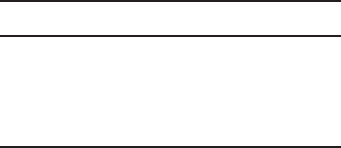
HEADWORKS AND PRELIMINARY TREATMENT 20-23
where H
L
headloss, m
Q flow rate through the screen, m
3
/ s
g acceleration due to gravity 9.81 m/s
2
C coefficient of discharge for the screen
A effective open area of submerged screen, m
2
A typical value of C for a clean screen is 0.6. Actual values of C and A depend on the screen
design. These factors include the size and milling of slots, or, in the case of wire, the diameter
and weave. The percent open area is of particular importance. The values must be determined
experi
mentally. They should be obtained from the manufacturer of the screen. Some typical fine
screen openings and effective open areas are listed in Table 20-8 .
A s with coarse sc reens, the important determination is the headloss during operation when
the screen is partially clogged. Many manufacturers re
commend that the screen be operated at a
condition of being blinded 50 to 70 percent to improve capture efficiency.
Screenings Handling. The amount of solid material collected by fine screens is considerably
greater than with coarse screens because of the the smaller sc reen openings. Capture rates are a
function of the sc
reen opening. Some examples are 87 to 93 percent for 3 mm band screens, 78
to 81 percent for 6 mm band screens. Other fine screens have similar relationships: 84 percent
for 3 mm and 71 to 76 percent for 6 mm (Makie and Oyler, 2007). A screw conveyor or belt
conveyor should be used to collect and transport the screenings to a was
her and compactor.
The design practice for treating and disposing of the screenings is discussed in Chapter 27.
20-5 COARSE SOLIDS REDUCTION
An alternative to capturing coarse solids on bar racks and/or screens is to use a mechanical device
to shred or grind the solids and return them to the flow. Three of the most common devices are
comminutors, macerators, and grinders.
There is a divergence of views on the d
esirability of using this technique for handling coarse
solids. One view is that the coarse solids should be removed from the wastewater early in the flow
scheme to eliminate downstream problems. Another view is that the shredded material is easily
handled by downstream processes
. Of particular concern are rag and plastic materials that form
strings or ropes that wrap around pump impellers, accumulate on clarifier mechanisms and air dif-
fusers, clog sludge pipelines, and foul heat exchangers. Plastic limits the potential for land applica-
tion of biosolids. For certain pro
cesses, such as membrane bioreactors (MBRs), or the requirement
to produce Class A biosolids, coarse solids reduction is not an option. Fine screens must be used.
TABLE 20-8
Fine-screen openings and effective open areas
Hole spacing, mm Open area, %
9 55
640
335
1 31
A dapted from Keller et al., 2006.
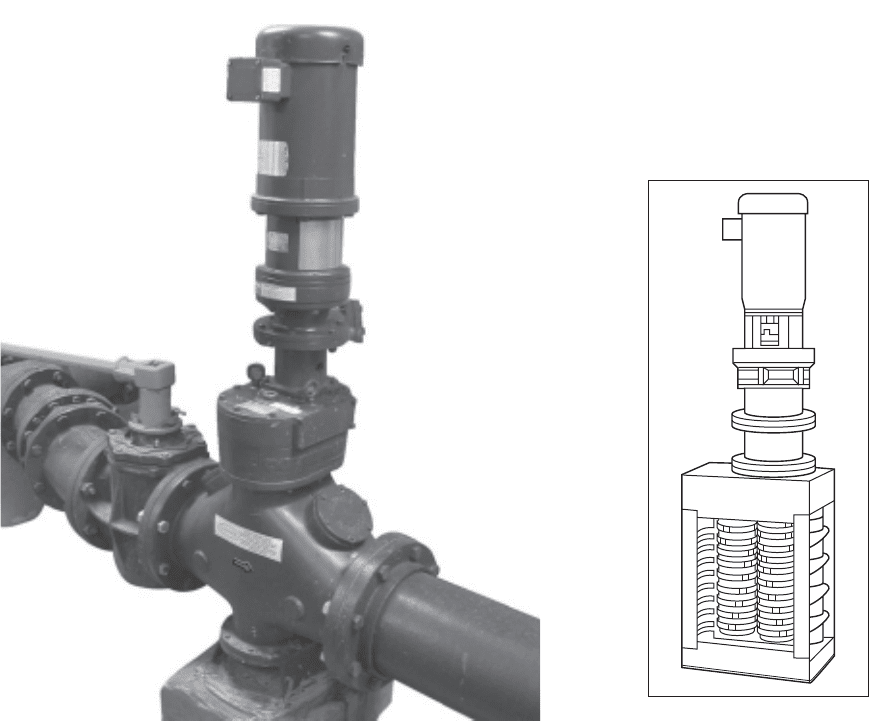
20-24 WATER AND WASTEWATER ENGINEERING
Comminutors
A typical comminutor uses a stationary horizontal screen to intercept the solids in the flow and a
rotating or oscillating cutting bar to shear the material. The solids are reduced in size to between
6 and 20 mm. They pass downstream. Although they were commonly used in the past, most new
facilities use screens
, macerators, or grinders.
Macerators
Macerators are slow-speed grind ers that typically use two sets of counterrotating blade assem-
blies ( Figure 20-9 ). The tolerance on the macerator blades assemblies is small enough (typically,
6 to 9 mm) that the material passing through is effectively chopped. This chopping action redu
ces
the potential for producing ropes of rags and plastic.
FIGURE 20-9
Photo and isometric drawing of a macerator.
( Sources: Mackenzie L. Davis; Metcalf & Eddy, 2003.)

HEADWORKS AND PRELIMINARY TREATMENT 20-25
Grinders
Grinders pulverize the solids by a high-speed rotating assembly. The cutting blades force the
material through a stationary grid that encloses the assembly.
Design Considerations
The capacity and redundancy requirements for solids reduction devices are the same as those for
coarse screens. They may be located downstream of grit chambers to reduce wear on the cutting
mechanism, but typically they are plac
ed ahead of grit chambers to prevent rags, bags, and other
debris from fouling the grit removal equipment. As with the screens, channels are constructed
with a bypass and provisions for isolating the channel and dewatering it when maintenance is
required.
T ypical headloss through these devices is
100 to 300 mm and can approach 900 mm in large
units at maximum flows.
Because these units are sold as stand-alone devices, no detailed design is required. However,
manufacturers’ data must be consulted for data on rec ommended channel
dimensions, capacity,
headloss, submergence, and power requirements. In evaluating alternatives, the ratings should be
decreased by about 80 percent because the manufacturers use clean water to establish the ratings
(Metcalf & Eddy, 2003).
Hint from the Field. Once you take it out, d
o not put it back in (Pugh, 2008).
20-6 GRIT REMOVAL
Sand, gravel, broken glass, egg shells, and other material having a settling velocity substantially
greater than the organic material in wastewater is called grit. Grit removal is provided to protec t
mechanical equipment from abrasion and wear; reduce the formation of deposits in pipelines
and channels; and reduce the frequency of dige
ster cleaning that is required because of accumu-
lated grit.
A secondary, but none-the-less extremely desirable goal of the grit removal system is to
separate the grit from the organic material in the wastewater. This separation allows the organic
material to be treated in subsequent processes.
Theory
At its most fundamental level, the controlling parameter in grit removal is the settling velocity of
the particle. The behavior of settling particles in a grit chamber is commonly described as Type I
(discrete particle) sedimentation. This phenomenon is described in Chapter 10.
To separate the inert grit material from organic particles, grit removal
devices depend on the
difference in specific gravity between organic and inorganic solids. In standard gravity separation
all particles are assumed to settle in accord with Newton’s equation (Equation 10-8), repeated
here for convenience,
v
gd
C
s
s
D
12
4
3
/
()
⎡
⎣
⎢
⎤
⎦
⎥
(20-8)
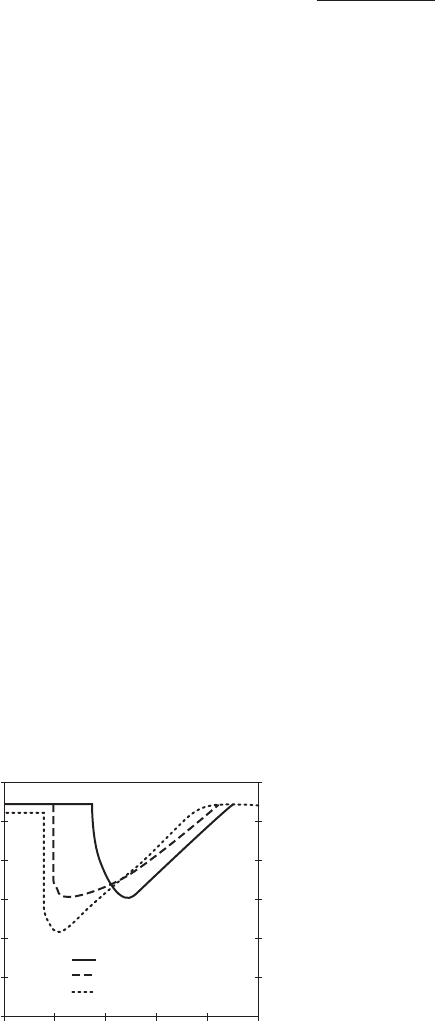
20-26 WATER AND WASTEWATER ENGINEERING
and, by Camp’s equation (1942), to be scoured at a velocity
v
gd
f
s
scour
/
12
8
1 000
()
(),
⎡
⎣
⎢
⎤
⎦
⎥
(20-9)
where v
s
settling velocity of particle, m/s
g acceleration due to gravity 9.81 m/s
2
s
density of particle, kg/m
3
density of water, kg/m
3
d particle diameter, m
C
D
drag coefficient, dimensionless
v
scour
scour velocity, m/s
dimensionless constant
f dimensionless Darcy-Weisbach friction factor
The dimensionless constant ( ) ranges from 0.04 to 0.06. The Darcy-Weisbach friction fac-
tor is taken to be in the range 0.02 to 0.03.
In a horizontal-flow grit chamber, to assure removal of the grit an
d scour of organic matter
that settles, three conditions must be met (Steel and McGhee, 1979):
1 . The overflow rate of the chamber must be equal to the settling velocity of the inert grit
particle.
2. The horizontal velocity must be less than the scour velocity of the inert particles.
3. The horizontal velocity must be greater than the scour velocity of the organic particles.
By the 1950s, a design philosophy had evolved specifying that horizontal-flow grit chambers
should capture sand particles with a diameter of 200 m and a specific gravity of 2.65 (Fair and
Geyer, 1954). The solution of Newton’s equation and the scour equation using these assumption
s
yields an overflow rate of 0.021 m/s and a horizontal velocity between 0.056 m/s and 0.23 m/s.
Unfortunately, this specification ignored observations made in the 1920s that the specific
gravity of grit was in the range of 1.4 to 1.6 (Metcalf & Eddy, 1930). As shown in Figure 20-10 ,
subsequent work has revealed a range of specific gravities from
about 1.1 to 2.7 (Eutek, 2008;
Metcalf & Eddy, 2003). In addition, it is recognized that grease and other organic matter frequently
0.50
0
100 200 300 400 500
1.00
1.50
2.00
2.50
3.00
Specific gravity
Sand equivalent size (SES), m
Akron, OH WWTP
Lowell, MA WWTP
Clermont, OH WWTP
FIGURE 20-10
Variation in specific gravity of grit.
( Source: Courtesy of Eutek, 2008.)
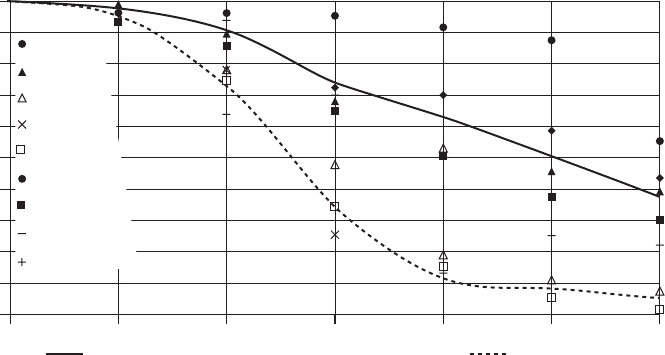
HEADWORKS AND PRELIMINARY TREATMENT 20-27
coats the inorganic grit particle. Thus, neither the specific gravity nor the size of a grit particle can
be described in terms of a sand grain alone. A more realistic measure called the sand equivalent
size (SES) is preferred (Wilson et al., 2007a). SES is the size of a clean sand particle that settles at
the same rate as a grit particle.
The selection of the 200 m particle diameter for removal appears to be arbitrary. Typical
particle size d istributions of particles are shown in Figure 20-11 . From the figure it is obvious
that a large fraction of the grit has a SES less than 200 m diameter. As noted in 1971 and
illustrated in Figure 20-11 , the grit in wastewater of coastal cities often contains
a large fraction
of particles less than 200 m in diameter (WPCF, 1971).
With peak flows and/or combined sewer systems, particles as large as gravel may be trans-
ported to the wastewater treatment plant. The implication of this high variability in the character
of the grit is that the design of the grit chamber, while based on fundamental settling theory, must
provide sufficient operational flexibility to adjust to local circ
umstances.
Grit Removal Alternatives
There are four general types of grit removal systems: horizontal-flow grit chambers, detritus
tanks, aerated grit chambers, and vortex-flow grit chambers. The horizontal-flow grit chamber is,
fundamentally, a velocity-controlled channel. The velocity is controlled by a proportional weir or
Parshall flume. The detritus tank is a square horizontal-flow grit c
hamber. The tank is basically
a sedimentation basin with a very short detention time. The flow is directed across the tank by a
series of gates or weirs and discharges over a weir that runs the length of the opposite side of the
tank. In aerated grit chambers, air is introduced along one side of of the tank near the bottom and
causes a s
piral roll pattern perpendicular to the flow through the tank ( Figure 20-12 ). The vortex
systems rely on a mechanically induced vortex to capture grit ( Figure 20-13 ).
While they have been used for many decades, horizontal-flow grit chambers and detritus
tanks are no longer favored in the United States. The remainder of this disc
ussion focuses on the
preferred alternatives: aerated grit chambers and vortex chambers.
0
0 50 100 150 200 250 300
10
20
30
40
50
60
70
80
90
100
Cumulative percent passing
SES, m
Average SES
Average coastal SES
FL 1-1
FL 1-2
FL 2
FL 3
Green Bay, WI
Grimes, IA
Lowell, MA
Hyperion WWTP
Seattle, WA
FIGURE 20-11
Grit SES particle size distributions.
( Source: Courtesy of Eutek, 2008.)
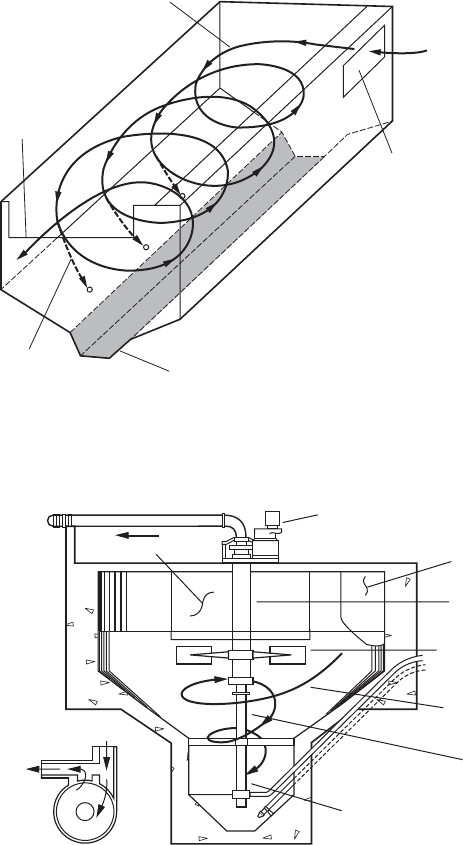
20-28 WATER AND WASTEWATER ENGINEERING
Aerated Grit Chamber. As the wastewater moves through the chamber in a spiral pattern
( Figure 20-12 ), heavier grit particles settle to the bottom of the tank. Lighter particles that are
principally organic remain in suspension and are carried out of the tank. The velocity of roll of
water across the bottom of the tank controls the size of particles of a given s pecific gravity that
will settle out (Albrecht, 1967; Sawicki, 2004). The rolling action induced
by the air diffusers
is independent of flow through the tank. The rate of air diffusion and the tank s hape govern the
Spiral liquid
flow pattern
Outlet weir
Inlet
Trajectory of
grit particles
Grit collection channel
FIGURE 20-12
Spiral roll pattern in an aerated aerated grit chamber. ( Source: Metcalf
& Eddy, 2003.)
Drive torque tube
controls velocity
inside the chamber
Air scour header
Drive unit
Rotating turbine
Airlift pump
Inlet
Grit movement pattern
along outer edge of uni
t
Outlet
Outlet
Plan
Inlet
Section
FIGURE 20-13
Vortex grit chamber. ( Source: Metcalf & Eddy, 2003.)

HEADWORKS AND PRELIMINARY TREATMENT 20-29
rate of velocity of the roll. The particles that are settled out are moved by the spiral flow of the
water across the bottom of the tank to a grit hopper or trough. The grit is removed from the hop-
per with one of the following: chain and bucket collectors, sc rew augers, clamshell buckets, or
recessed impeller or air lift pumps.
The advantages and disadvantages of aerated
grit chambers are summarized in Table 20-9 .
Vortex Grit Chamber. Wastewater is brought into the chamber tangentially ( Figure 20-13 ).
At the center of the chamber a rotating turbine with adjustable-pitch blades along with the cone-
shaped floor produces a spiraling, doughnut-shaped flow pattern. This pattern tends to lift the
lighter organic particles and settle the grit into a grit sump. The effluent outlet ha
s twice the width
of the influent flume. This results in a lower exit velocity than the influent velocity and thus pre-
vents grit from being drawn into the effluent flow. It should be noted that centrifugal acceleration
does not play a significant role in removing the particles. The velocities are too low.
Solids are removed from the sump by a grit pump or an air lift pump. Typic
ally, air or water
scour is used to loosen the compacted grit just before it is removed from the chamber.
The advantages and disadvantages of vortex grit chambers are summarized in Table 20-10 .
Aerated Grit Chamber Design Practice
A cross section of the chamber is shown in Figure 20-14 . The bottom slope is set at a 45 degree
angle. The collection channel (also called a sump or hopper ) for grit is sized based on the antici-
pated quantity of grit. Air is introduced along one side near the bottom of the tank to induce a spi-
ral roll velocity pattern perpendicular to the flow throu
gh the tank. The rate of air diffusion and
the tank shape govern the rate of roll and, thereby, the size of the particle with a given specific
Advantages Disadvantages
Efficiency constant over wide range of flow Power consumption is high
Headloss is minimal Labor required for air system maintenance
Organic content can be controlled by air rate Volatile organic compounds may be released
Chamber can be used to add and mix
chemicals Odor may be an issue
Slight pre-aeration may reduce septic conditions Labor for grit removal equipment maintenance
TABLE 20-9
Advantages and disadvantages of aerated grit chambers
Sources: WEF, 1998, and Spangler, 2006.
Advantages Disadvantages
Efficiency constant over wide range of flow Proprietary design
Energy efficient Compaction of grit
Headloss is minimal Turbine blades may collect rags
Small footprint
No submerged bearings
TABLE 20-10
Advantages and disadvantages of vortex grit chambers
A dapted from WEF, 1998, and Spangler, 2006.
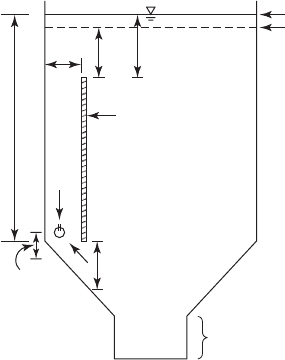
20-30 WATER AND WASTEWATER ENGINEERING
gravity that will be removed. A large number of variables affect the air lift pumping energy and
its effect on the roll pattern in the tank.
Although there are no formal arguments for the required efficiency of grit removal, typically
it has been assumed that a properly functioning aerated grit chamber should remove 100 percent
of the sand fraction greater than 200 m in diameter and 65 to 75
percent of the sand fraction
between 100 and 200 m. In addition, the organic content of the captured grit should not exceed
10 percent (Imhoff and Imhoff, 1979).
Modern treatment technology suc h as fine bubble diffused aeration and membrane filtra-
tion (Chapters 23 and 26) appear to warrant higher efficiency. Wilson et al. (2007b) suggest that
95 percent removal of the SES 60
m diameter is required to prevent inert grit from settling in
fine bubble aeration systems. From Figure 20-11 , it appears that about 95 percent removal of
particles greater than 50 m SES virtually eliminates grit from the wastewater.
Capacity and Redundancy. Aerated grit chambers must be able to pass the extreme peak
hydraulic flow rate with the largest unit out of servi
ce. In addition, the grit handling equipment
(collection channel and mechanical equipment) must be able to handle the highest grit loading at
the highest flow rate.
Location. Typically, the grit chamber is placed downstream of coarse screens or mechanical
coarse solids reduction devices. They
may be placed upstream of fine screens to protect the fine
screen from excessive wear.
Detention Time. Experience has shown that a detention time of 2 to 5 minutes at peak hourly
flow is sufficient to achieve greater than 95 percent removal of the the traditional design particle
size (200 m diameter, specific gravity of 2.65). T
ypically, the detention time is set at 3 minutes
at peak hourly flow (Metcalf & Eddy, 2003; WEF, 1998). Detention times ranging from 3.6 to
7.8 minutes at average flow conditions have been reported to achieve efficiencies ranging from
94 to 98.8 percent (Morales and Reinhart, 1984). Longer detention times improve grit removal
and may be necessary to captu
re smaller grit particles (WEF, 1998).
Geometry. The shape of the grit chamber is designed to enhance the spiral roll of the wastewa-
ter as it passes through the chamber. Although some aerated grit chambers have been formed to a
1 m
d
b
Baffle
Air
header
0.6–1 m
Grit hopper
d
b
v
b
Wastewater level
Weir crest
d
T
Submergence S
FIGURE 20-14
Aerated grit chamber with dimension notations. The dis-
tance of the air header to the sloped wall of the grit chamber
is noted as 0.6–1 m.
